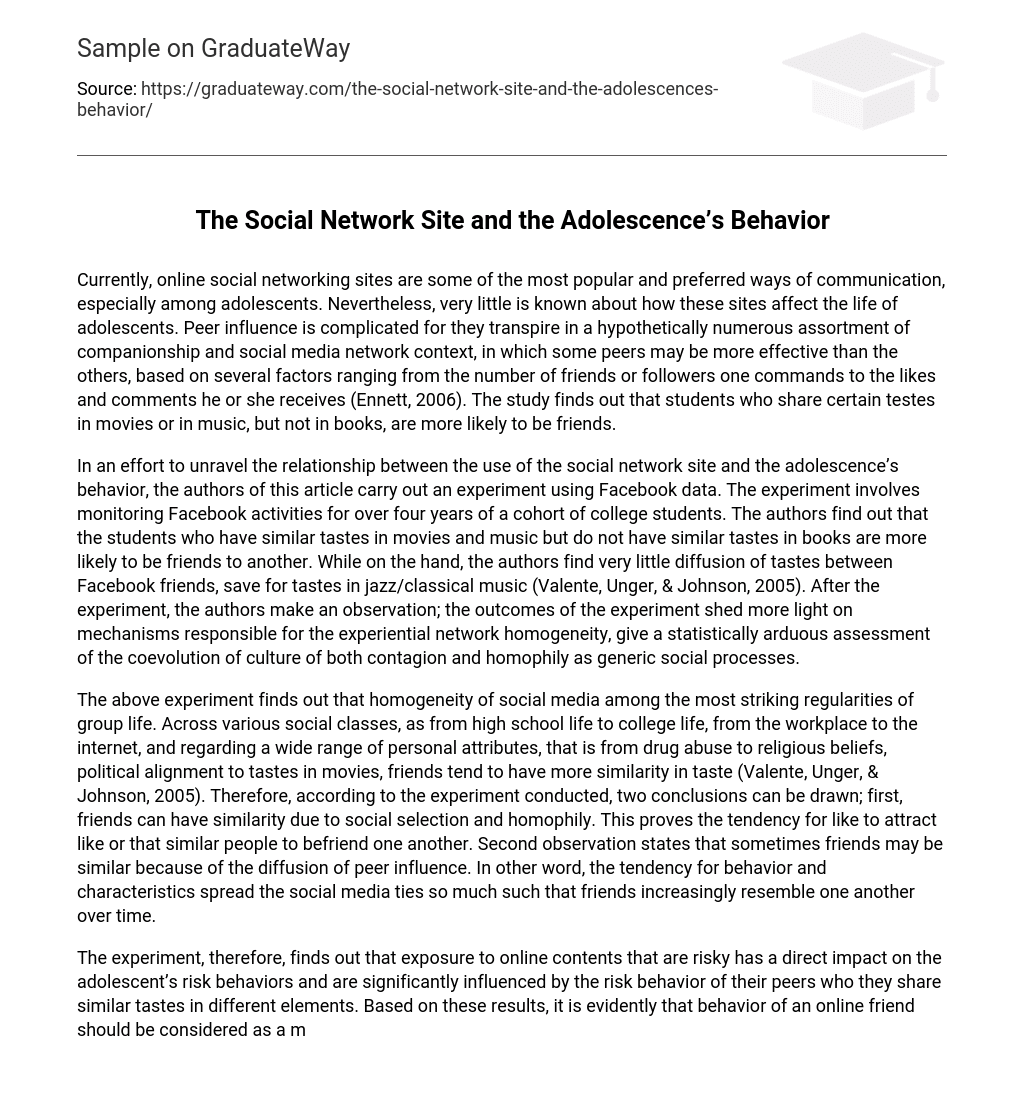Currently, online social networking sites are some of the most popular and preferred ways of communication, especially among adolescents. Nevertheless, very little is known about how these sites affect the life of adolescents. Peer influence is complicated for they transpire in a hypothetically numerous assortment of companionship and social media network context, in which some peers may be more effective than the others, based on several factors ranging from the number of friends or followers one commands to the likes and comments he or she receives (Ennett, 2006). The study finds out that students who share certain testes in movies or in music, but not in books, are more likely to be friends.
In an effort to unravel the relationship between the use of the social network site and the adolescence’s behavior, the authors of this article carry out an experiment using Facebook data. The experiment involves monitoring Facebook activities for over four years of a cohort of college students. The authors find out that the students who have similar tastes in movies and music but do not have similar tastes in books are more likely to be friends to another. While on the hand, the authors find very little diffusion of tastes between Facebook friends, save for tastes in jazz/classical music (Valente, Unger, & Johnson, 2005). After the experiment, the authors make an observation; the outcomes of the experiment shed more light on mechanisms responsible for the experiential network homogeneity, give a statistically arduous assessment of the coevolution of culture of both contagion and homophily as generic social processes.
The above experiment finds out that homogeneity of social media among the most striking regularities of group life. Across various social classes, as from high school life to college life, from the workplace to the internet, and regarding a wide range of personal attributes, that is from drug abuse to religious beliefs, political alignment to tastes in movies, friends tend to have more similarity in taste (Valente, Unger, & Johnson, 2005). Therefore, according to the experiment conducted, two conclusions can be drawn; first, friends can have similarity due to social selection and homophily. This proves the tendency for like to attract like or that similar people to befriend one another. Second observation states that sometimes friends may be similar because of the diffusion of peer influence. In other word, the tendency for behavior and characteristics spread the social media ties so much such that friends increasingly resemble one another over time.
The experiment, therefore, finds out that exposure to online contents that are risky has a direct impact on the adolescent’s risk behaviors and are significantly influenced by the risk behavior of their peers who they share similar tastes in different elements. Based on these results, it is evidently that behavior of an online friend should be considered as a major source of peer influence. The authors, therefore, suggest that an increased effort should focus on educating adolescents about the negative factors associated with an illicit online relationship. In the situation of adolescence substance use, essential correspondence as a mechanism of infection reflects the impression that persons who subjugate the same position monitoring one another’s behavior and ultimately espouse risk-taking conducts at the same time. In this case, peer pressure does not automatically encompass conversation or direct communication, but an observation.
Some of these articles still relevant to date and will remain so for years to come. This is because the findings in these are articles are not influenced or changed with the change in time. The research is based on the findings of an individual’s behavior and how they adapt to the environment. The research shows how individuals adapt to the environment and respond to its change too. This, therefore, means that, even if time changes, the behavior of a person remains unchanged. This makes a lot of sense why some of these articles remain relevant for than 20 years and will remain relevant.
It should also be noted that some of these research articles factor in both present and future analysis. When research was carried out, the researchers did not only collect current trends, they also factored in human behavior in years ahead. However, in the recent past, geneticist discovered an evidence of recent and rapid changes in genomes of human in response to the pressure of civilization. They found out that, fair skin allows adoption of more sunlight. The geneticists found out that human nature has genetically evolved a bit in over 10,000 years (Fujimoto, & Valente, 2012). These findings further give more reason why some of the articles are relevant to date, despite all the changes in evolution in the recent past.
References
- Ennett, S. T., Bauman, K. E., Hussong, A., Faris, R., Foshee, V. A., Cai, L., & DuRant, R. H. (2006). The peer context of adolescent substance use: Findings from social network analysis. Journal of research on adolescence, 16(2), 159-186.
- Valente, T. W., Unger, J. B., & Johnson, C. A. (2005). Do popular students smoke? The association between popularity and smoking among middle school students. Journal of Adolescent Health, 37(4), 323-329.
- Fujimoto, K., & Valente, T. W. (2012). Social network influences on adolescent substance use: disentangling structural equivalence from cohesion. Social Science & Medicine, 74(12), 1952-1960.





